A Qualitative Study on Staff Awareness About Post-Op Pain Management
VerifiedAdded on 2023/05/28
|12
|2810
|349
Report
AI Summary
This report presents a qualitative study investigating the importance of staff awareness in post-operative pain management within perioperative care settings. The research aims to identify the significance of post-operative pain management, critically evaluate the impact of staff awareness, identify issues hindering effective staff awareness, and recommend strategies for improved pain management. The study employs a literature review to establish the concept of peri-operative care and the importance of both pain management and staff awareness. Data collection involves both secondary data from published resources and primary qualitative data obtained through face-to-face interviews with nurses, utilizing non-probability sampling. Ethical considerations, including data protection and participant consent, are addressed to ensure research integrity. The findings aim to contribute to better nursing practices and improve patient outcomes by enhancing staff awareness and pain management techniques.
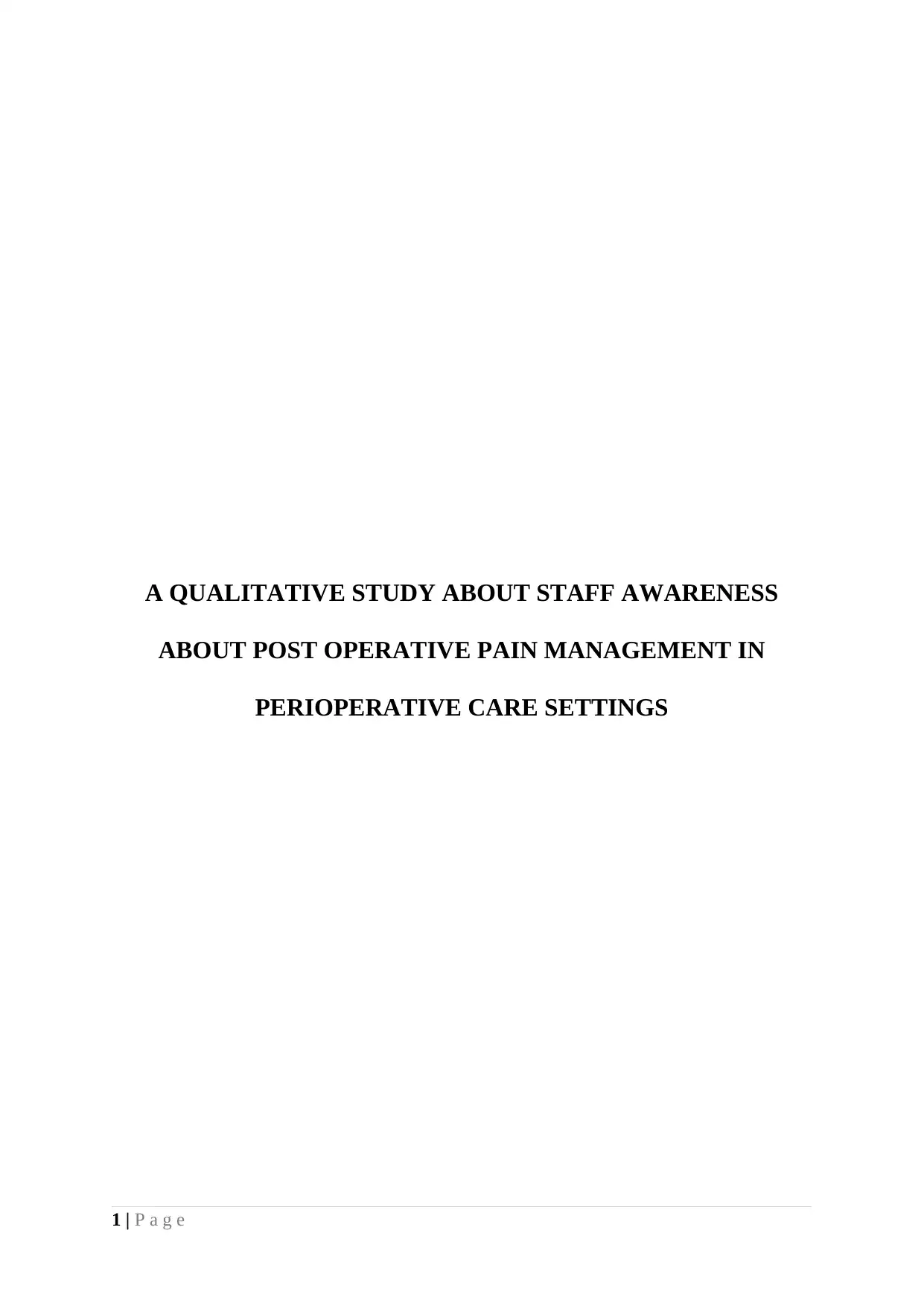
A QUALITATIVE STUDY ABOUT STAFF AWARENESS
ABOUT POST OPERATIVE PAIN MANAGEMENT IN
PERIOPERATIVE CARE SETTINGS
1 | P a g e
ABOUT POST OPERATIVE PAIN MANAGEMENT IN
PERIOPERATIVE CARE SETTINGS
1 | P a g e
Paraphrase This Document
Need a fresh take? Get an instant paraphrase of this document with our AI Paraphraser
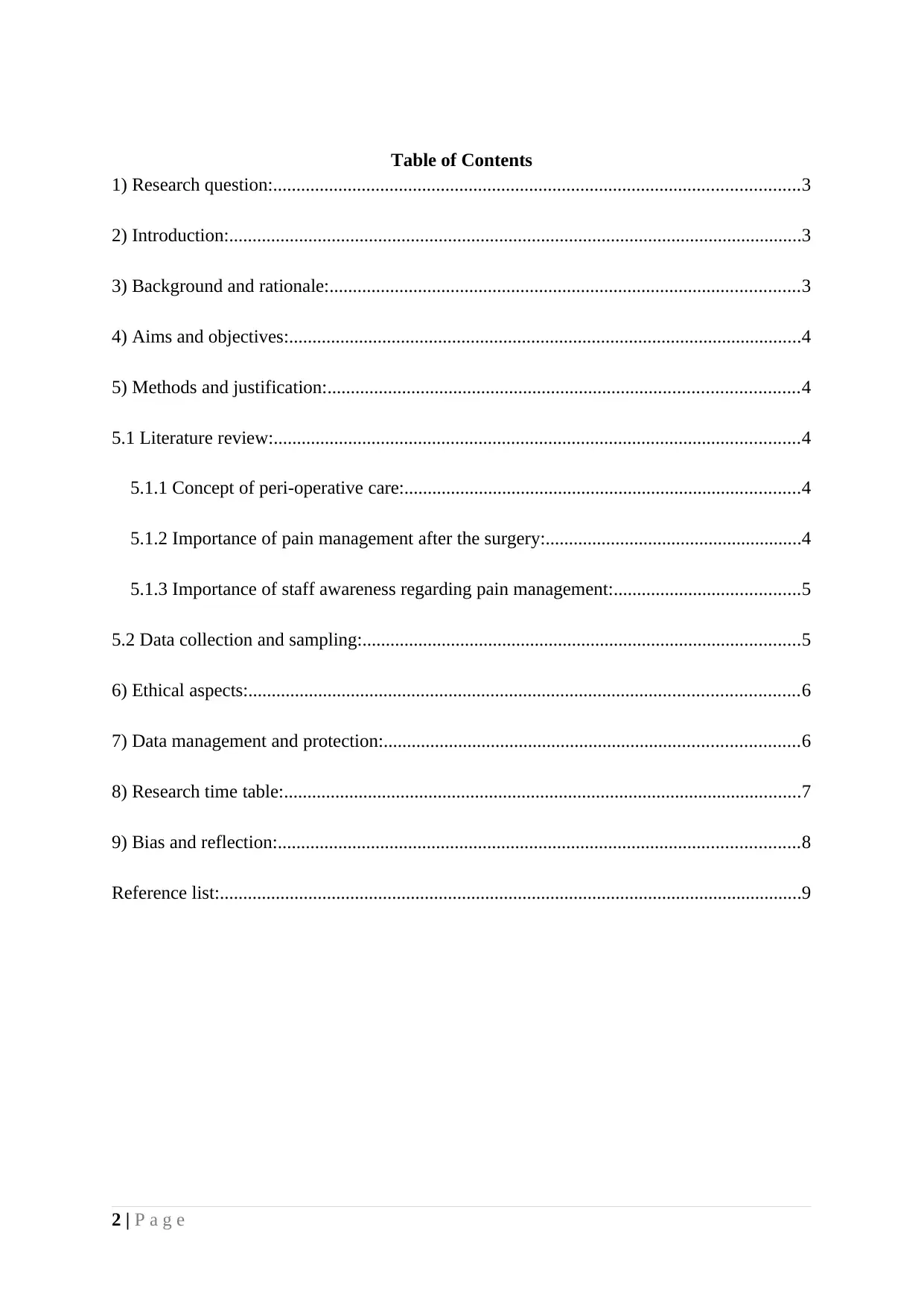
Table of Contents
1) Research question:.................................................................................................................3
2) Introduction:...........................................................................................................................3
3) Background and rationale:.....................................................................................................3
4) Aims and objectives:..............................................................................................................4
5) Methods and justification:.....................................................................................................4
5.1 Literature review:.................................................................................................................4
5.1.1 Concept of peri-operative care:.....................................................................................4
5.1.2 Importance of pain management after the surgery:.......................................................4
5.1.3 Importance of staff awareness regarding pain management:........................................5
5.2 Data collection and sampling:..............................................................................................5
6) Ethical aspects:......................................................................................................................6
7) Data management and protection:.........................................................................................6
8) Research time table:...............................................................................................................7
9) Bias and reflection:................................................................................................................8
Reference list:.............................................................................................................................9
2 | P a g e
1) Research question:.................................................................................................................3
2) Introduction:...........................................................................................................................3
3) Background and rationale:.....................................................................................................3
4) Aims and objectives:..............................................................................................................4
5) Methods and justification:.....................................................................................................4
5.1 Literature review:.................................................................................................................4
5.1.1 Concept of peri-operative care:.....................................................................................4
5.1.2 Importance of pain management after the surgery:.......................................................4
5.1.3 Importance of staff awareness regarding pain management:........................................5
5.2 Data collection and sampling:..............................................................................................5
6) Ethical aspects:......................................................................................................................6
7) Data management and protection:.........................................................................................6
8) Research time table:...............................................................................................................7
9) Bias and reflection:................................................................................................................8
Reference list:.............................................................................................................................9
2 | P a g e
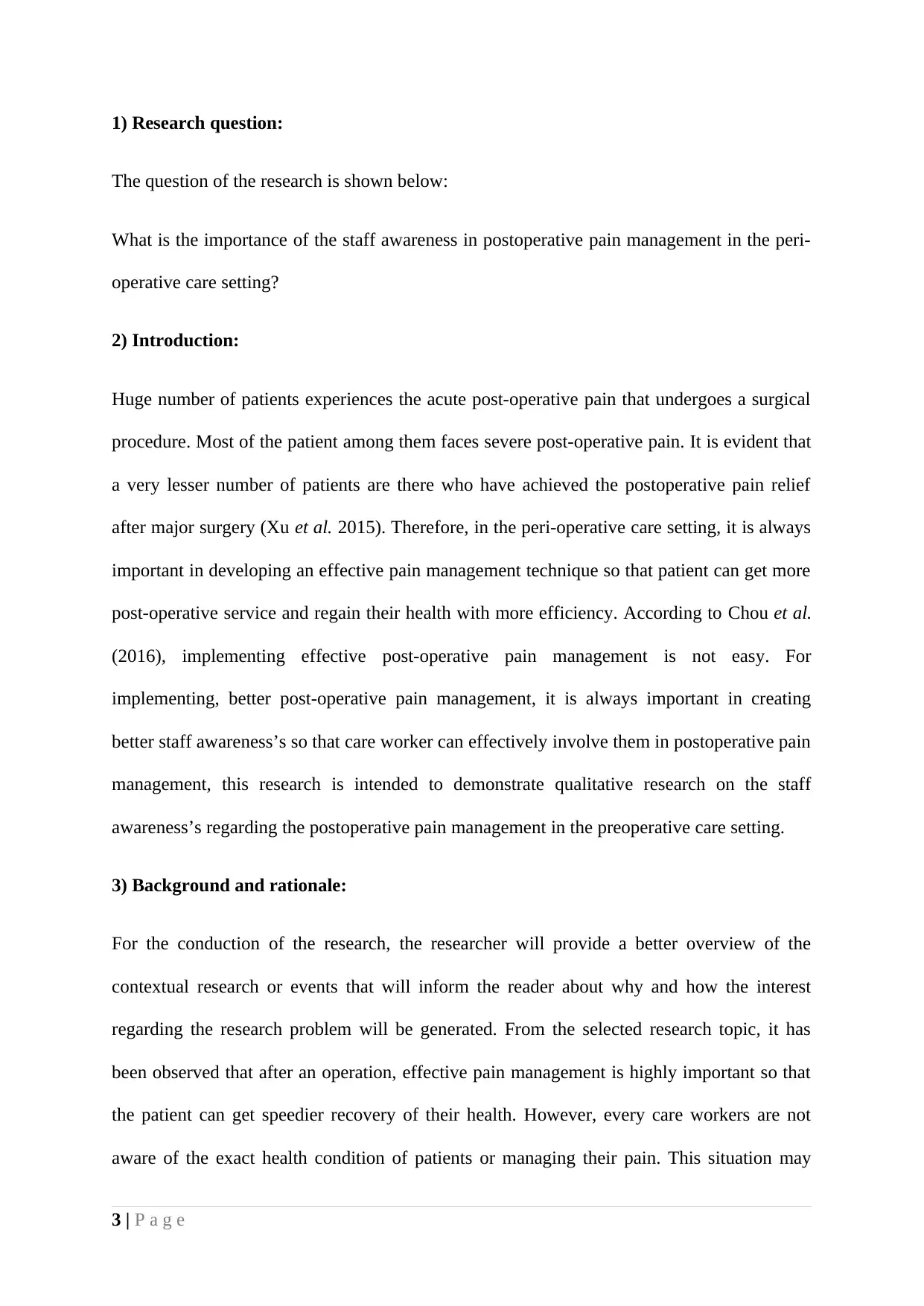
1) Research question:
The question of the research is shown below:
What is the importance of the staff awareness in postoperative pain management in the peri-
operative care setting?
2) Introduction:
Huge number of patients experiences the acute post-operative pain that undergoes a surgical
procedure. Most of the patient among them faces severe post-operative pain. It is evident that
a very lesser number of patients are there who have achieved the postoperative pain relief
after major surgery (Xu et al. 2015). Therefore, in the peri-operative care setting, it is always
important in developing an effective pain management technique so that patient can get more
post-operative service and regain their health with more efficiency. According to Chou et al.
(2016), implementing effective post-operative pain management is not easy. For
implementing, better post-operative pain management, it is always important in creating
better staff awareness’s so that care worker can effectively involve them in postoperative pain
management, this research is intended to demonstrate qualitative research on the staff
awareness’s regarding the postoperative pain management in the preoperative care setting.
3) Background and rationale:
For the conduction of the research, the researcher will provide a better overview of the
contextual research or events that will inform the reader about why and how the interest
regarding the research problem will be generated. From the selected research topic, it has
been observed that after an operation, effective pain management is highly important so that
the patient can get speedier recovery of their health. However, every care workers are not
aware of the exact health condition of patients or managing their pain. This situation may
3 | P a g e
The question of the research is shown below:
What is the importance of the staff awareness in postoperative pain management in the peri-
operative care setting?
2) Introduction:
Huge number of patients experiences the acute post-operative pain that undergoes a surgical
procedure. Most of the patient among them faces severe post-operative pain. It is evident that
a very lesser number of patients are there who have achieved the postoperative pain relief
after major surgery (Xu et al. 2015). Therefore, in the peri-operative care setting, it is always
important in developing an effective pain management technique so that patient can get more
post-operative service and regain their health with more efficiency. According to Chou et al.
(2016), implementing effective post-operative pain management is not easy. For
implementing, better post-operative pain management, it is always important in creating
better staff awareness’s so that care worker can effectively involve them in postoperative pain
management, this research is intended to demonstrate qualitative research on the staff
awareness’s regarding the postoperative pain management in the preoperative care setting.
3) Background and rationale:
For the conduction of the research, the researcher will provide a better overview of the
contextual research or events that will inform the reader about why and how the interest
regarding the research problem will be generated. From the selected research topic, it has
been observed that after an operation, effective pain management is highly important so that
the patient can get speedier recovery of their health. However, every care workers are not
aware of the exact health condition of patients or managing their pain. This situation may
3 | P a g e
⊘ This is a preview!⊘
Do you want full access?
Subscribe today to unlock all pages.

Trusted by 1+ million students worldwide
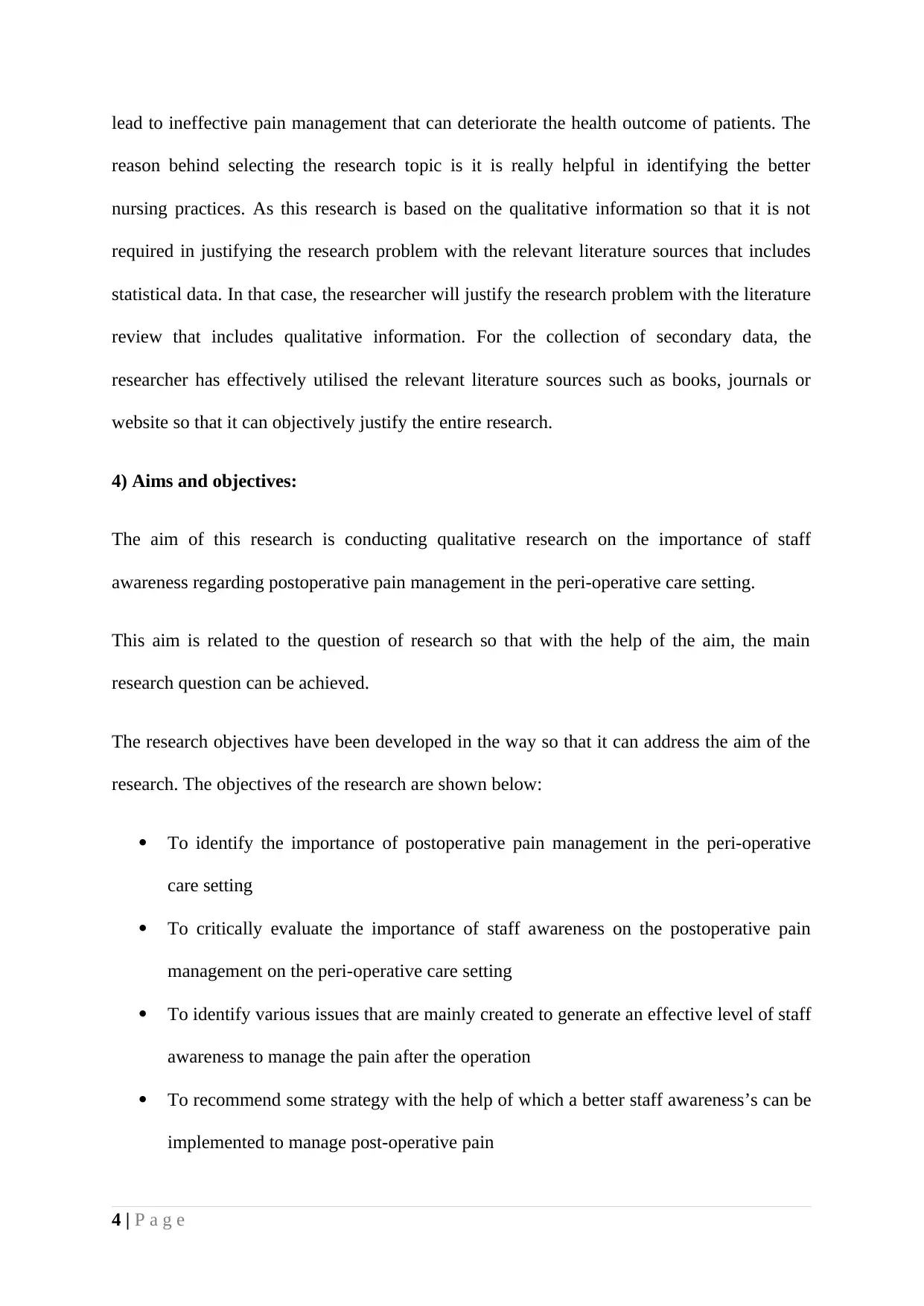
lead to ineffective pain management that can deteriorate the health outcome of patients. The
reason behind selecting the research topic is it is really helpful in identifying the better
nursing practices. As this research is based on the qualitative information so that it is not
required in justifying the research problem with the relevant literature sources that includes
statistical data. In that case, the researcher will justify the research problem with the literature
review that includes qualitative information. For the collection of secondary data, the
researcher has effectively utilised the relevant literature sources such as books, journals or
website so that it can objectively justify the entire research.
4) Aims and objectives:
The aim of this research is conducting qualitative research on the importance of staff
awareness regarding postoperative pain management in the peri-operative care setting.
This aim is related to the question of research so that with the help of the aim, the main
research question can be achieved.
The research objectives have been developed in the way so that it can address the aim of the
research. The objectives of the research are shown below:
To identify the importance of postoperative pain management in the peri-operative
care setting
To critically evaluate the importance of staff awareness on the postoperative pain
management on the peri-operative care setting
To identify various issues that are mainly created to generate an effective level of staff
awareness to manage the pain after the operation
To recommend some strategy with the help of which a better staff awareness’s can be
implemented to manage post-operative pain
4 | P a g e
reason behind selecting the research topic is it is really helpful in identifying the better
nursing practices. As this research is based on the qualitative information so that it is not
required in justifying the research problem with the relevant literature sources that includes
statistical data. In that case, the researcher will justify the research problem with the literature
review that includes qualitative information. For the collection of secondary data, the
researcher has effectively utilised the relevant literature sources such as books, journals or
website so that it can objectively justify the entire research.
4) Aims and objectives:
The aim of this research is conducting qualitative research on the importance of staff
awareness regarding postoperative pain management in the peri-operative care setting.
This aim is related to the question of research so that with the help of the aim, the main
research question can be achieved.
The research objectives have been developed in the way so that it can address the aim of the
research. The objectives of the research are shown below:
To identify the importance of postoperative pain management in the peri-operative
care setting
To critically evaluate the importance of staff awareness on the postoperative pain
management on the peri-operative care setting
To identify various issues that are mainly created to generate an effective level of staff
awareness to manage the pain after the operation
To recommend some strategy with the help of which a better staff awareness’s can be
implemented to manage post-operative pain
4 | P a g e
Paraphrase This Document
Need a fresh take? Get an instant paraphrase of this document with our AI Paraphraser
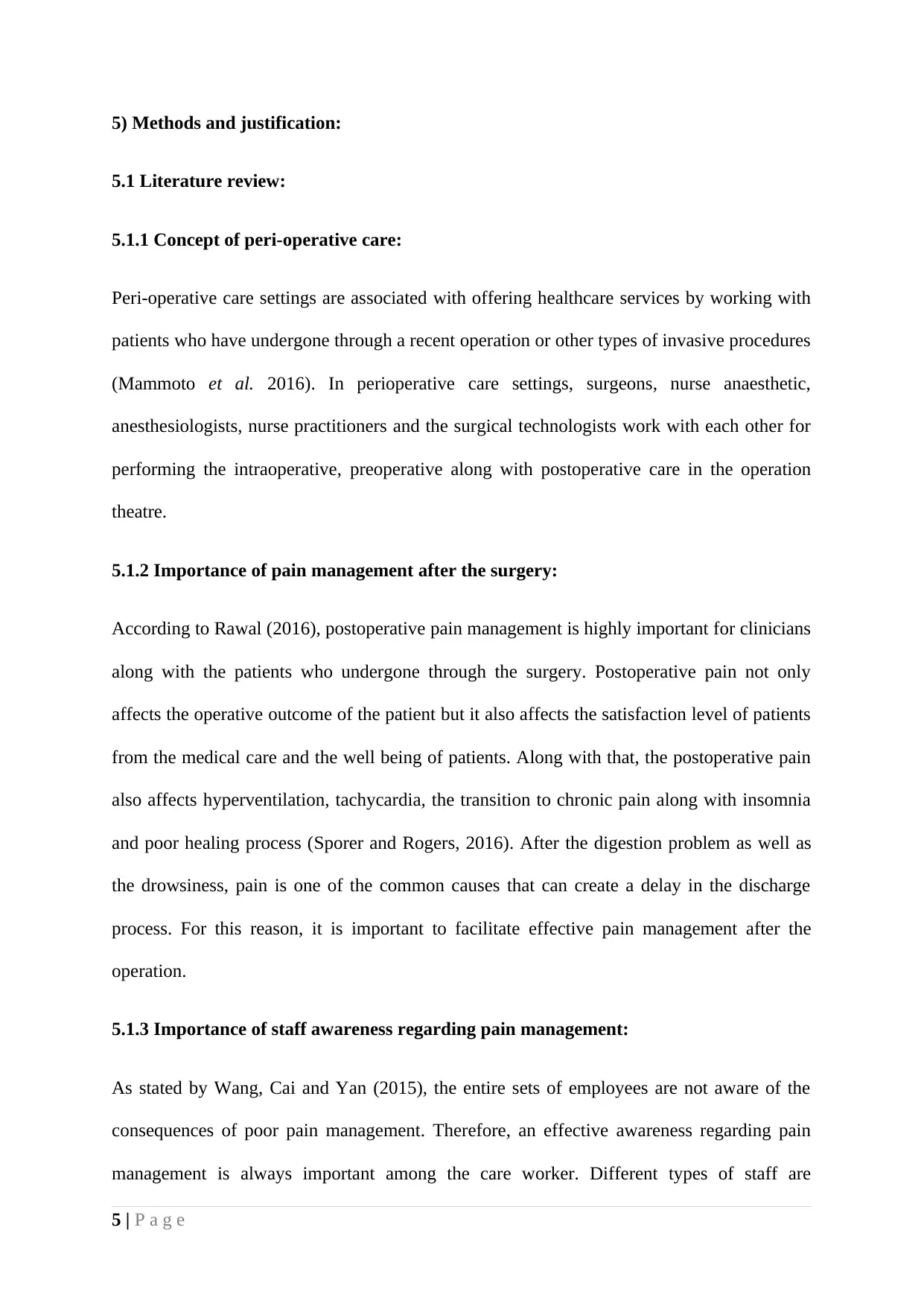
5) Methods and justification:
5.1 Literature review:
5.1.1 Concept of peri-operative care:
Peri-operative care settings are associated with offering healthcare services by working with
patients who have undergone through a recent operation or other types of invasive procedures
(Mammoto et al. 2016). In perioperative care settings, surgeons, nurse anaesthetic,
anesthesiologists, nurse practitioners and the surgical technologists work with each other for
performing the intraoperative, preoperative along with postoperative care in the operation
theatre.
5.1.2 Importance of pain management after the surgery:
According to Rawal (2016), postoperative pain management is highly important for clinicians
along with the patients who undergone through the surgery. Postoperative pain not only
affects the operative outcome of the patient but it also affects the satisfaction level of patients
from the medical care and the well being of patients. Along with that, the postoperative pain
also affects hyperventilation, tachycardia, the transition to chronic pain along with insomnia
and poor healing process (Sporer and Rogers, 2016). After the digestion problem as well as
the drowsiness, pain is one of the common causes that can create a delay in the discharge
process. For this reason, it is important to facilitate effective pain management after the
operation.
5.1.3 Importance of staff awareness regarding pain management:
As stated by Wang, Cai and Yan (2015), the entire sets of employees are not aware of the
consequences of poor pain management. Therefore, an effective awareness regarding pain
management is always important among the care worker. Different types of staff are
5 | P a g e
5.1 Literature review:
5.1.1 Concept of peri-operative care:
Peri-operative care settings are associated with offering healthcare services by working with
patients who have undergone through a recent operation or other types of invasive procedures
(Mammoto et al. 2016). In perioperative care settings, surgeons, nurse anaesthetic,
anesthesiologists, nurse practitioners and the surgical technologists work with each other for
performing the intraoperative, preoperative along with postoperative care in the operation
theatre.
5.1.2 Importance of pain management after the surgery:
According to Rawal (2016), postoperative pain management is highly important for clinicians
along with the patients who undergone through the surgery. Postoperative pain not only
affects the operative outcome of the patient but it also affects the satisfaction level of patients
from the medical care and the well being of patients. Along with that, the postoperative pain
also affects hyperventilation, tachycardia, the transition to chronic pain along with insomnia
and poor healing process (Sporer and Rogers, 2016). After the digestion problem as well as
the drowsiness, pain is one of the common causes that can create a delay in the discharge
process. For this reason, it is important to facilitate effective pain management after the
operation.
5.1.3 Importance of staff awareness regarding pain management:
As stated by Wang, Cai and Yan (2015), the entire sets of employees are not aware of the
consequences of poor pain management. Therefore, an effective awareness regarding pain
management is always important among the care worker. Different types of staff are
5 | P a g e
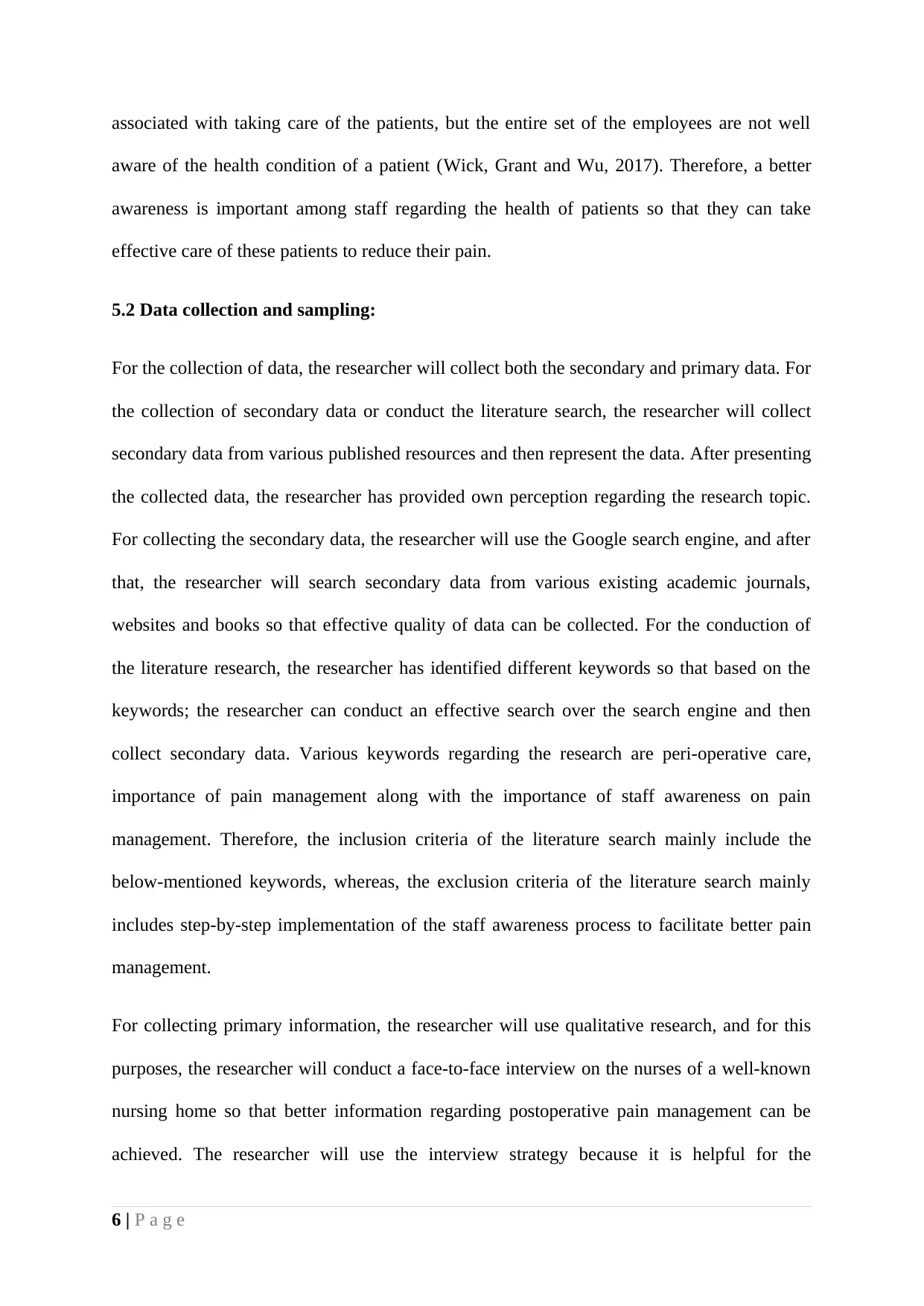
associated with taking care of the patients, but the entire set of the employees are not well
aware of the health condition of a patient (Wick, Grant and Wu, 2017). Therefore, a better
awareness is important among staff regarding the health of patients so that they can take
effective care of these patients to reduce their pain.
5.2 Data collection and sampling:
For the collection of data, the researcher will collect both the secondary and primary data. For
the collection of secondary data or conduct the literature search, the researcher will collect
secondary data from various published resources and then represent the data. After presenting
the collected data, the researcher has provided own perception regarding the research topic.
For collecting the secondary data, the researcher will use the Google search engine, and after
that, the researcher will search secondary data from various existing academic journals,
websites and books so that effective quality of data can be collected. For the conduction of
the literature research, the researcher has identified different keywords so that based on the
keywords; the researcher can conduct an effective search over the search engine and then
collect secondary data. Various keywords regarding the research are peri-operative care,
importance of pain management along with the importance of staff awareness on pain
management. Therefore, the inclusion criteria of the literature search mainly include the
below-mentioned keywords, whereas, the exclusion criteria of the literature search mainly
includes step-by-step implementation of the staff awareness process to facilitate better pain
management.
For collecting primary information, the researcher will use qualitative research, and for this
purposes, the researcher will conduct a face-to-face interview on the nurses of a well-known
nursing home so that better information regarding postoperative pain management can be
achieved. The researcher will use the interview strategy because it is helpful for the
6 | P a g e
aware of the health condition of a patient (Wick, Grant and Wu, 2017). Therefore, a better
awareness is important among staff regarding the health of patients so that they can take
effective care of these patients to reduce their pain.
5.2 Data collection and sampling:
For the collection of data, the researcher will collect both the secondary and primary data. For
the collection of secondary data or conduct the literature search, the researcher will collect
secondary data from various published resources and then represent the data. After presenting
the collected data, the researcher has provided own perception regarding the research topic.
For collecting the secondary data, the researcher will use the Google search engine, and after
that, the researcher will search secondary data from various existing academic journals,
websites and books so that effective quality of data can be collected. For the conduction of
the literature research, the researcher has identified different keywords so that based on the
keywords; the researcher can conduct an effective search over the search engine and then
collect secondary data. Various keywords regarding the research are peri-operative care,
importance of pain management along with the importance of staff awareness on pain
management. Therefore, the inclusion criteria of the literature search mainly include the
below-mentioned keywords, whereas, the exclusion criteria of the literature search mainly
includes step-by-step implementation of the staff awareness process to facilitate better pain
management.
For collecting primary information, the researcher will use qualitative research, and for this
purposes, the researcher will conduct a face-to-face interview on the nurses of a well-known
nursing home so that better information regarding postoperative pain management can be
achieved. The researcher will use the interview strategy because it is helpful for the
6 | P a g e
⊘ This is a preview!⊘
Do you want full access?
Subscribe today to unlock all pages.

Trusted by 1+ million students worldwide
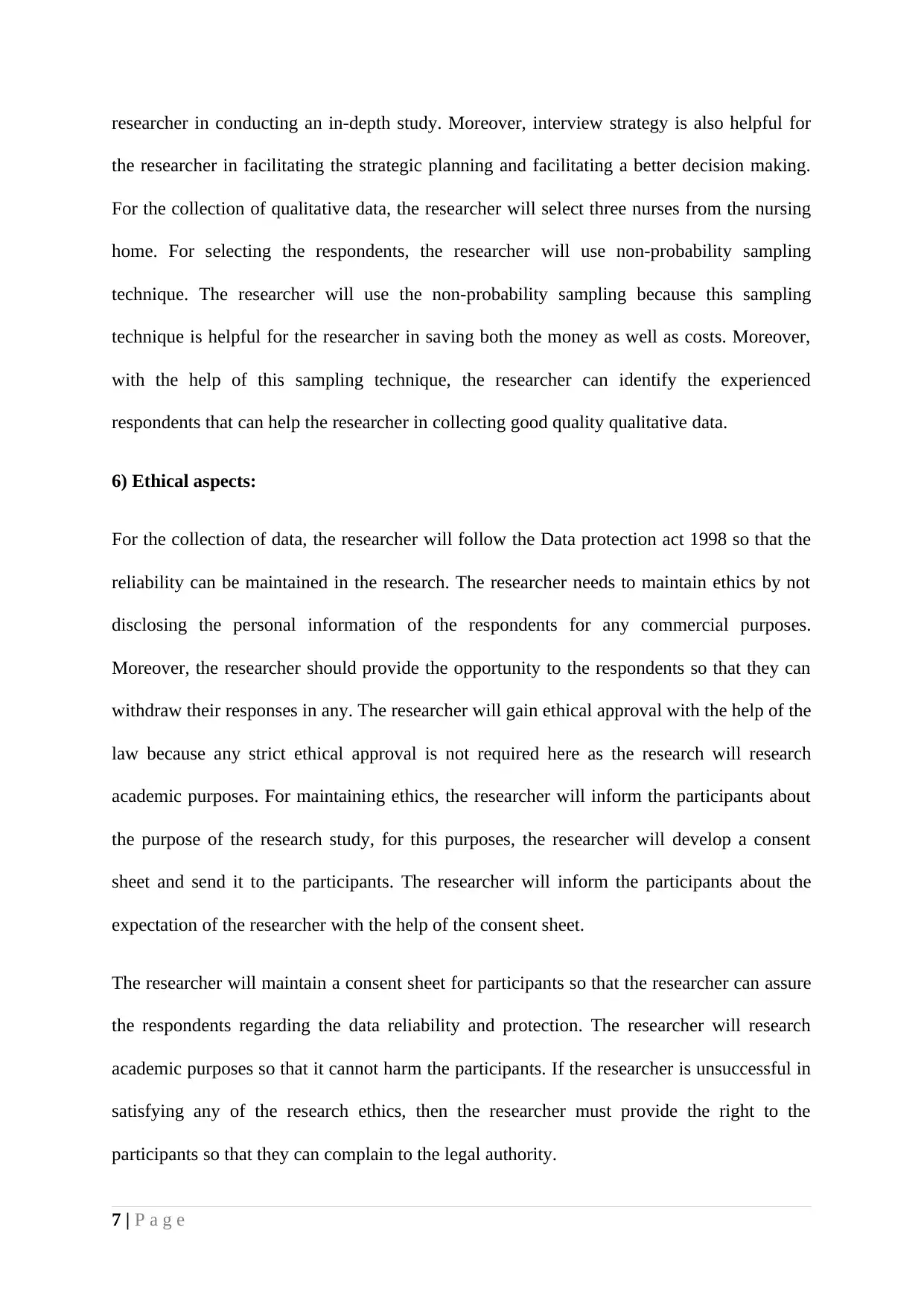
researcher in conducting an in-depth study. Moreover, interview strategy is also helpful for
the researcher in facilitating the strategic planning and facilitating a better decision making.
For the collection of qualitative data, the researcher will select three nurses from the nursing
home. For selecting the respondents, the researcher will use non-probability sampling
technique. The researcher will use the non-probability sampling because this sampling
technique is helpful for the researcher in saving both the money as well as costs. Moreover,
with the help of this sampling technique, the researcher can identify the experienced
respondents that can help the researcher in collecting good quality qualitative data.
6) Ethical aspects:
For the collection of data, the researcher will follow the Data protection act 1998 so that the
reliability can be maintained in the research. The researcher needs to maintain ethics by not
disclosing the personal information of the respondents for any commercial purposes.
Moreover, the researcher should provide the opportunity to the respondents so that they can
withdraw their responses in any. The researcher will gain ethical approval with the help of the
law because any strict ethical approval is not required here as the research will research
academic purposes. For maintaining ethics, the researcher will inform the participants about
the purpose of the research study, for this purposes, the researcher will develop a consent
sheet and send it to the participants. The researcher will inform the participants about the
expectation of the researcher with the help of the consent sheet.
The researcher will maintain a consent sheet for participants so that the researcher can assure
the respondents regarding the data reliability and protection. The researcher will research
academic purposes so that it cannot harm the participants. If the researcher is unsuccessful in
satisfying any of the research ethics, then the researcher must provide the right to the
participants so that they can complain to the legal authority.
7 | P a g e
the researcher in facilitating the strategic planning and facilitating a better decision making.
For the collection of qualitative data, the researcher will select three nurses from the nursing
home. For selecting the respondents, the researcher will use non-probability sampling
technique. The researcher will use the non-probability sampling because this sampling
technique is helpful for the researcher in saving both the money as well as costs. Moreover,
with the help of this sampling technique, the researcher can identify the experienced
respondents that can help the researcher in collecting good quality qualitative data.
6) Ethical aspects:
For the collection of data, the researcher will follow the Data protection act 1998 so that the
reliability can be maintained in the research. The researcher needs to maintain ethics by not
disclosing the personal information of the respondents for any commercial purposes.
Moreover, the researcher should provide the opportunity to the respondents so that they can
withdraw their responses in any. The researcher will gain ethical approval with the help of the
law because any strict ethical approval is not required here as the research will research
academic purposes. For maintaining ethics, the researcher will inform the participants about
the purpose of the research study, for this purposes, the researcher will develop a consent
sheet and send it to the participants. The researcher will inform the participants about the
expectation of the researcher with the help of the consent sheet.
The researcher will maintain a consent sheet for participants so that the researcher can assure
the respondents regarding the data reliability and protection. The researcher will research
academic purposes so that it cannot harm the participants. If the researcher is unsuccessful in
satisfying any of the research ethics, then the researcher must provide the right to the
participants so that they can complain to the legal authority.
7 | P a g e
Paraphrase This Document
Need a fresh take? Get an instant paraphrase of this document with our AI Paraphraser
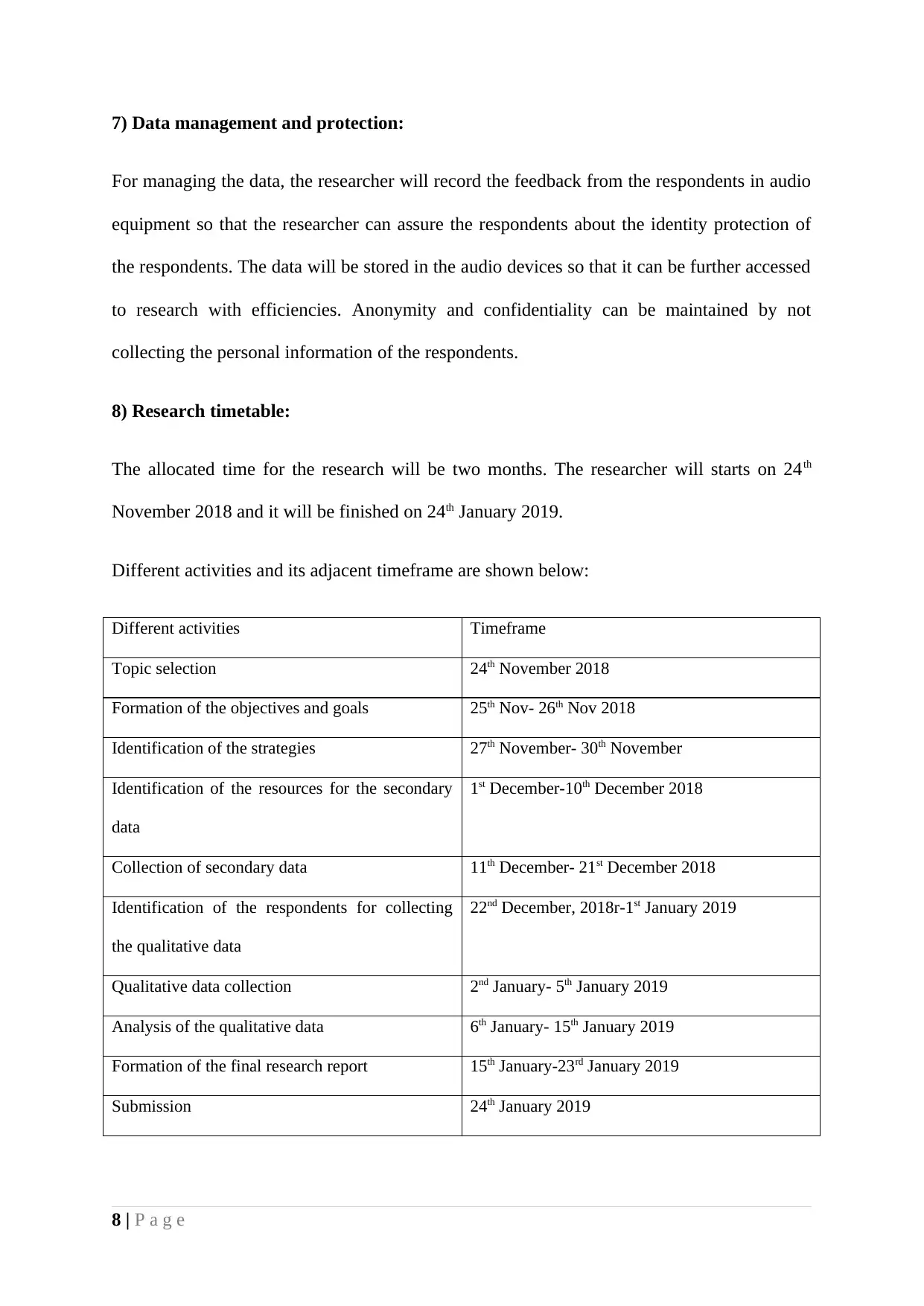
7) Data management and protection:
For managing the data, the researcher will record the feedback from the respondents in audio
equipment so that the researcher can assure the respondents about the identity protection of
the respondents. The data will be stored in the audio devices so that it can be further accessed
to research with efficiencies. Anonymity and confidentiality can be maintained by not
collecting the personal information of the respondents.
8) Research timetable:
The allocated time for the research will be two months. The researcher will starts on 24th
November 2018 and it will be finished on 24th January 2019.
Different activities and its adjacent timeframe are shown below:
Different activities Timeframe
Topic selection 24th November 2018
Formation of the objectives and goals 25th Nov- 26th Nov 2018
Identification of the strategies 27th November- 30th November
Identification of the resources for the secondary
data
1st December-10th December 2018
Collection of secondary data 11th December- 21st December 2018
Identification of the respondents for collecting
the qualitative data
22nd December, 2018r-1st January 2019
Qualitative data collection 2nd January- 5th January 2019
Analysis of the qualitative data 6th January- 15th January 2019
Formation of the final research report 15th January-23rd January 2019
Submission 24th January 2019
8 | P a g e
For managing the data, the researcher will record the feedback from the respondents in audio
equipment so that the researcher can assure the respondents about the identity protection of
the respondents. The data will be stored in the audio devices so that it can be further accessed
to research with efficiencies. Anonymity and confidentiality can be maintained by not
collecting the personal information of the respondents.
8) Research timetable:
The allocated time for the research will be two months. The researcher will starts on 24th
November 2018 and it will be finished on 24th January 2019.
Different activities and its adjacent timeframe are shown below:
Different activities Timeframe
Topic selection 24th November 2018
Formation of the objectives and goals 25th Nov- 26th Nov 2018
Identification of the strategies 27th November- 30th November
Identification of the resources for the secondary
data
1st December-10th December 2018
Collection of secondary data 11th December- 21st December 2018
Identification of the respondents for collecting
the qualitative data
22nd December, 2018r-1st January 2019
Qualitative data collection 2nd January- 5th January 2019
Analysis of the qualitative data 6th January- 15th January 2019
Formation of the final research report 15th January-23rd January 2019
Submission 24th January 2019
8 | P a g e
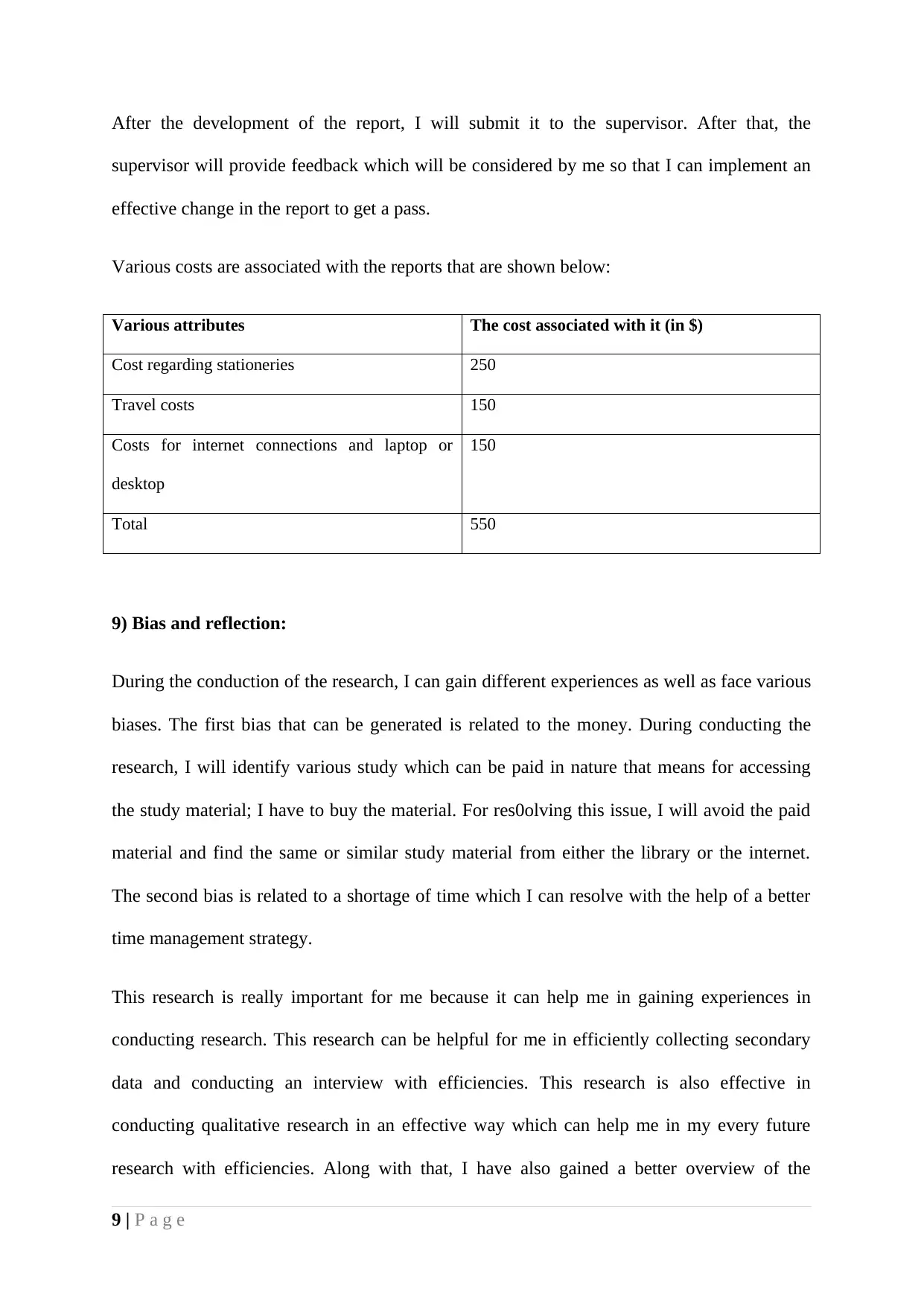
After the development of the report, I will submit it to the supervisor. After that, the
supervisor will provide feedback which will be considered by me so that I can implement an
effective change in the report to get a pass.
Various costs are associated with the reports that are shown below:
Various attributes The cost associated with it (in $)
Cost regarding stationeries 250
Travel costs 150
Costs for internet connections and laptop or
desktop
150
Total 550
9) Bias and reflection:
During the conduction of the research, I can gain different experiences as well as face various
biases. The first bias that can be generated is related to the money. During conducting the
research, I will identify various study which can be paid in nature that means for accessing
the study material; I have to buy the material. For res0olving this issue, I will avoid the paid
material and find the same or similar study material from either the library or the internet.
The second bias is related to a shortage of time which I can resolve with the help of a better
time management strategy.
This research is really important for me because it can help me in gaining experiences in
conducting research. This research can be helpful for me in efficiently collecting secondary
data and conducting an interview with efficiencies. This research is also effective in
conducting qualitative research in an effective way which can help me in my every future
research with efficiencies. Along with that, I have also gained a better overview of the
9 | P a g e
supervisor will provide feedback which will be considered by me so that I can implement an
effective change in the report to get a pass.
Various costs are associated with the reports that are shown below:
Various attributes The cost associated with it (in $)
Cost regarding stationeries 250
Travel costs 150
Costs for internet connections and laptop or
desktop
150
Total 550
9) Bias and reflection:
During the conduction of the research, I can gain different experiences as well as face various
biases. The first bias that can be generated is related to the money. During conducting the
research, I will identify various study which can be paid in nature that means for accessing
the study material; I have to buy the material. For res0olving this issue, I will avoid the paid
material and find the same or similar study material from either the library or the internet.
The second bias is related to a shortage of time which I can resolve with the help of a better
time management strategy.
This research is really important for me because it can help me in gaining experiences in
conducting research. This research can be helpful for me in efficiently collecting secondary
data and conducting an interview with efficiencies. This research is also effective in
conducting qualitative research in an effective way which can help me in my every future
research with efficiencies. Along with that, I have also gained a better overview of the
9 | P a g e
⊘ This is a preview!⊘
Do you want full access?
Subscribe today to unlock all pages.

Trusted by 1+ million students worldwide
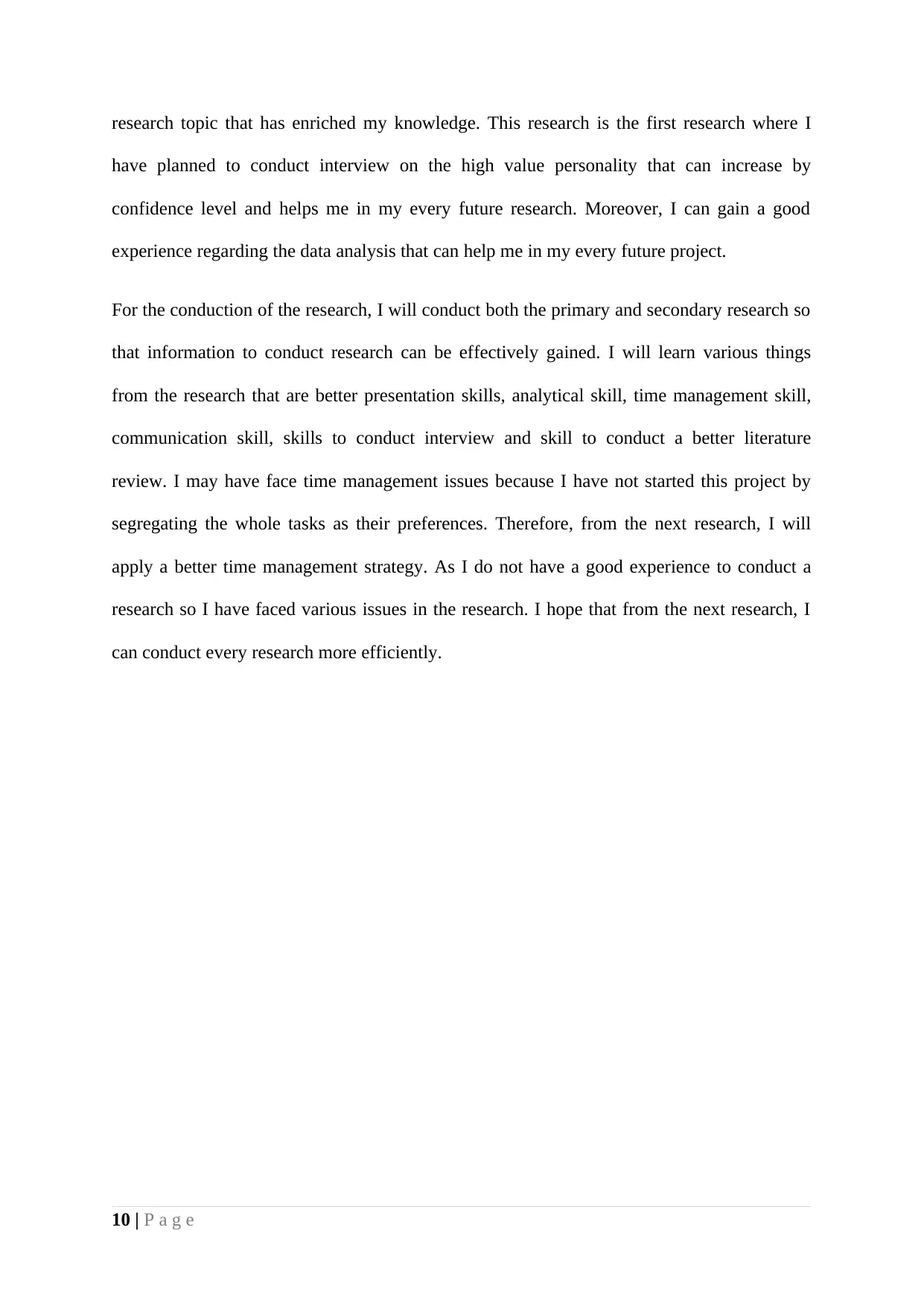
research topic that has enriched my knowledge. This research is the first research where I
have planned to conduct interview on the high value personality that can increase by
confidence level and helps me in my every future research. Moreover, I can gain a good
experience regarding the data analysis that can help me in my every future project.
For the conduction of the research, I will conduct both the primary and secondary research so
that information to conduct research can be effectively gained. I will learn various things
from the research that are better presentation skills, analytical skill, time management skill,
communication skill, skills to conduct interview and skill to conduct a better literature
review. I may have face time management issues because I have not started this project by
segregating the whole tasks as their preferences. Therefore, from the next research, I will
apply a better time management strategy. As I do not have a good experience to conduct a
research so I have faced various issues in the research. I hope that from the next research, I
can conduct every research more efficiently.
10 | P a g e
have planned to conduct interview on the high value personality that can increase by
confidence level and helps me in my every future research. Moreover, I can gain a good
experience regarding the data analysis that can help me in my every future project.
For the conduction of the research, I will conduct both the primary and secondary research so
that information to conduct research can be effectively gained. I will learn various things
from the research that are better presentation skills, analytical skill, time management skill,
communication skill, skills to conduct interview and skill to conduct a better literature
review. I may have face time management issues because I have not started this project by
segregating the whole tasks as their preferences. Therefore, from the next research, I will
apply a better time management strategy. As I do not have a good experience to conduct a
research so I have faced various issues in the research. I hope that from the next research, I
can conduct every research more efficiently.
10 | P a g e
Paraphrase This Document
Need a fresh take? Get an instant paraphrase of this document with our AI Paraphraser
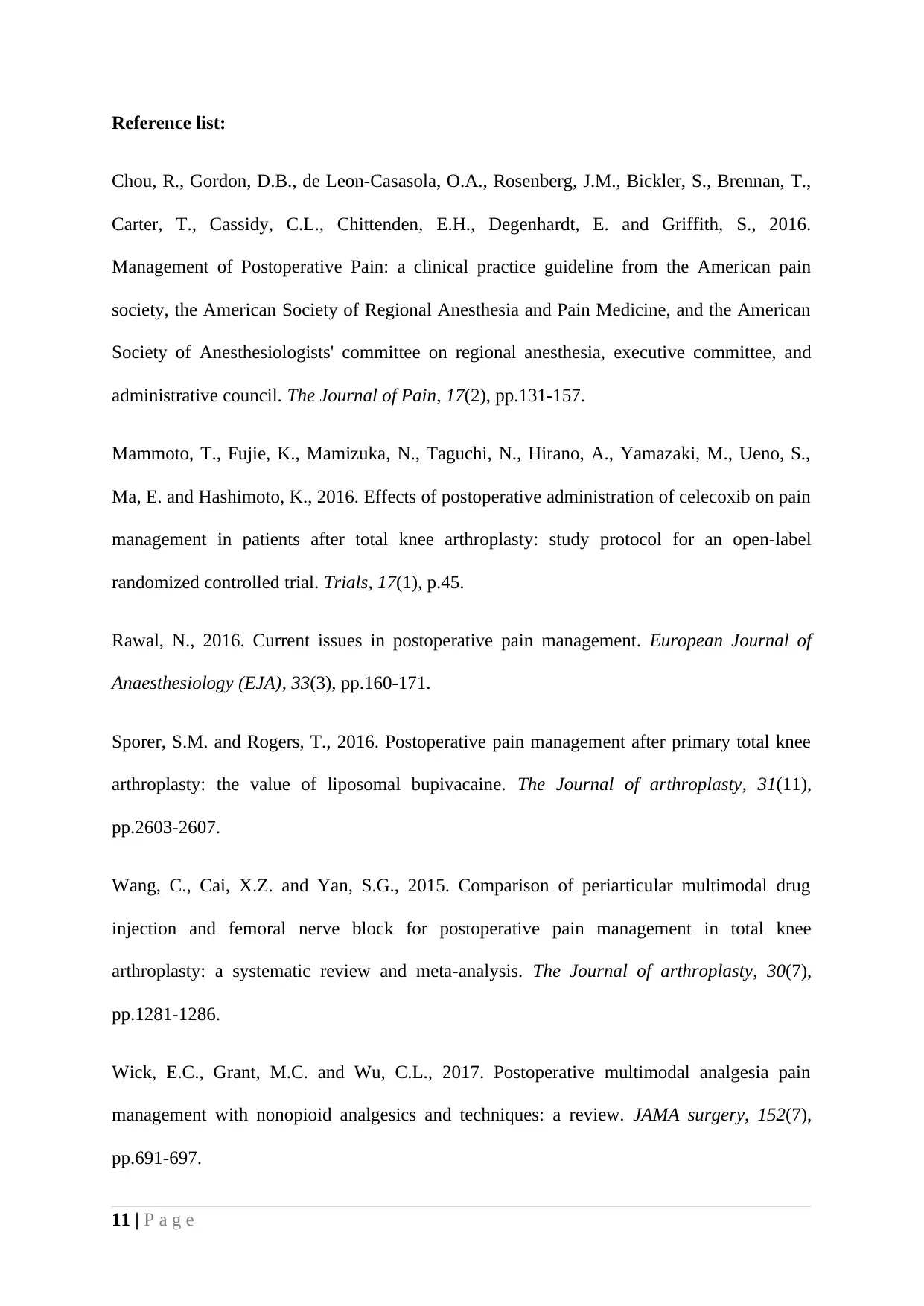
Reference list:
Chou, R., Gordon, D.B., de Leon-Casasola, O.A., Rosenberg, J.M., Bickler, S., Brennan, T.,
Carter, T., Cassidy, C.L., Chittenden, E.H., Degenhardt, E. and Griffith, S., 2016.
Management of Postoperative Pain: a clinical practice guideline from the American pain
society, the American Society of Regional Anesthesia and Pain Medicine, and the American
Society of Anesthesiologists' committee on regional anesthesia, executive committee, and
administrative council. The Journal of Pain, 17(2), pp.131-157.
Mammoto, T., Fujie, K., Mamizuka, N., Taguchi, N., Hirano, A., Yamazaki, M., Ueno, S.,
Ma, E. and Hashimoto, K., 2016. Effects of postoperative administration of celecoxib on pain
management in patients after total knee arthroplasty: study protocol for an open-label
randomized controlled trial. Trials, 17(1), p.45.
Rawal, N., 2016. Current issues in postoperative pain management. European Journal of
Anaesthesiology (EJA), 33(3), pp.160-171.
Sporer, S.M. and Rogers, T., 2016. Postoperative pain management after primary total knee
arthroplasty: the value of liposomal bupivacaine. The Journal of arthroplasty, 31(11),
pp.2603-2607.
Wang, C., Cai, X.Z. and Yan, S.G., 2015. Comparison of periarticular multimodal drug
injection and femoral nerve block for postoperative pain management in total knee
arthroplasty: a systematic review and meta-analysis. The Journal of arthroplasty, 30(7),
pp.1281-1286.
Wick, E.C., Grant, M.C. and Wu, C.L., 2017. Postoperative multimodal analgesia pain
management with nonopioid analgesics and techniques: a review. JAMA surgery, 152(7),
pp.691-697.
11 | P a g e
Chou, R., Gordon, D.B., de Leon-Casasola, O.A., Rosenberg, J.M., Bickler, S., Brennan, T.,
Carter, T., Cassidy, C.L., Chittenden, E.H., Degenhardt, E. and Griffith, S., 2016.
Management of Postoperative Pain: a clinical practice guideline from the American pain
society, the American Society of Regional Anesthesia and Pain Medicine, and the American
Society of Anesthesiologists' committee on regional anesthesia, executive committee, and
administrative council. The Journal of Pain, 17(2), pp.131-157.
Mammoto, T., Fujie, K., Mamizuka, N., Taguchi, N., Hirano, A., Yamazaki, M., Ueno, S.,
Ma, E. and Hashimoto, K., 2016. Effects of postoperative administration of celecoxib on pain
management in patients after total knee arthroplasty: study protocol for an open-label
randomized controlled trial. Trials, 17(1), p.45.
Rawal, N., 2016. Current issues in postoperative pain management. European Journal of
Anaesthesiology (EJA), 33(3), pp.160-171.
Sporer, S.M. and Rogers, T., 2016. Postoperative pain management after primary total knee
arthroplasty: the value of liposomal bupivacaine. The Journal of arthroplasty, 31(11),
pp.2603-2607.
Wang, C., Cai, X.Z. and Yan, S.G., 2015. Comparison of periarticular multimodal drug
injection and femoral nerve block for postoperative pain management in total knee
arthroplasty: a systematic review and meta-analysis. The Journal of arthroplasty, 30(7),
pp.1281-1286.
Wick, E.C., Grant, M.C. and Wu, C.L., 2017. Postoperative multimodal analgesia pain
management with nonopioid analgesics and techniques: a review. JAMA surgery, 152(7),
pp.691-697.
11 | P a g e
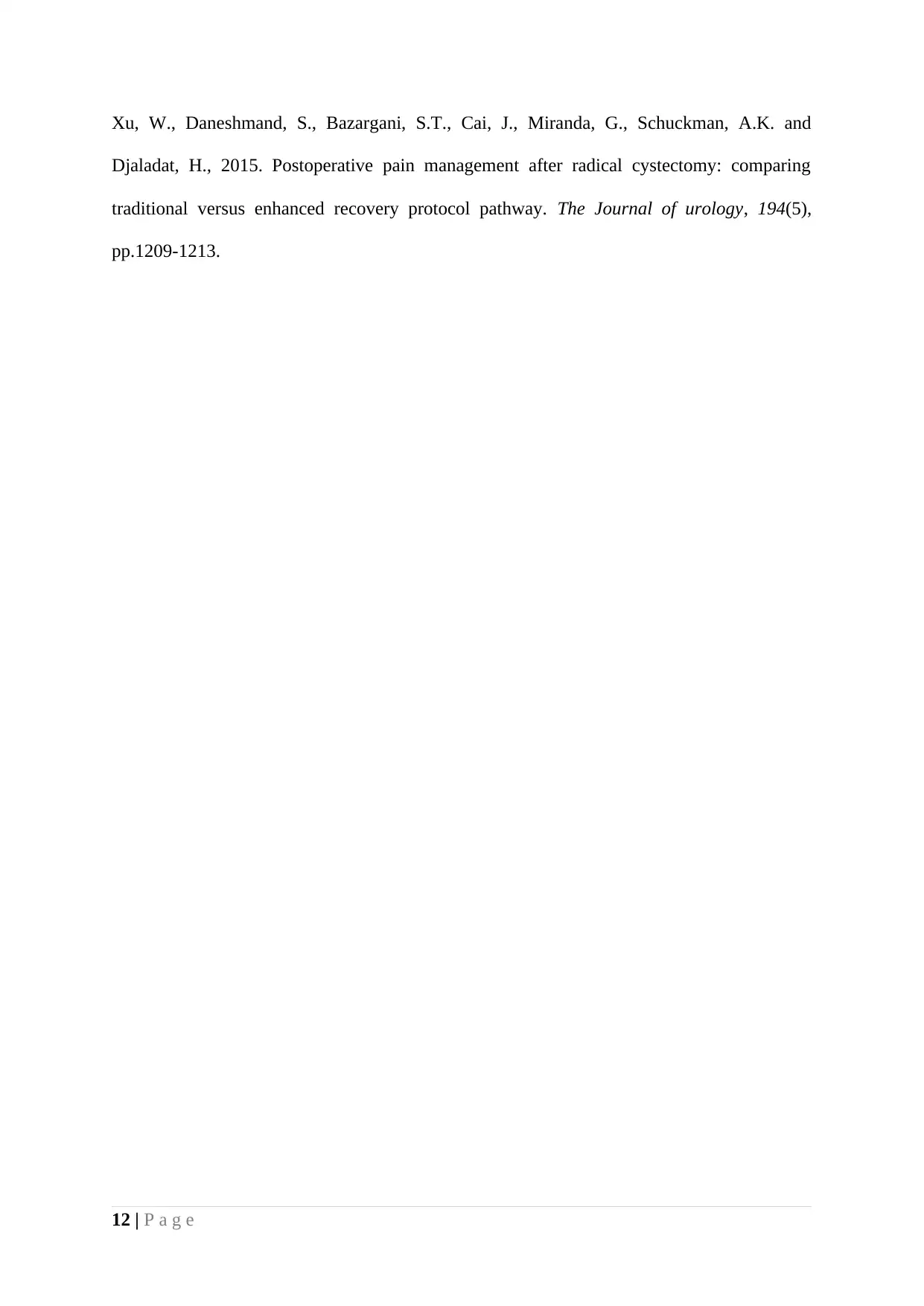
Xu, W., Daneshmand, S., Bazargani, S.T., Cai, J., Miranda, G., Schuckman, A.K. and
Djaladat, H., 2015. Postoperative pain management after radical cystectomy: comparing
traditional versus enhanced recovery protocol pathway. The Journal of urology, 194(5),
pp.1209-1213.
12 | P a g e
Djaladat, H., 2015. Postoperative pain management after radical cystectomy: comparing
traditional versus enhanced recovery protocol pathway. The Journal of urology, 194(5),
pp.1209-1213.
12 | P a g e
⊘ This is a preview!⊘
Do you want full access?
Subscribe today to unlock all pages.

Trusted by 1+ million students worldwide
1 out of 12
Related Documents
Your All-in-One AI-Powered Toolkit for Academic Success.
+13062052269
info@desklib.com
Available 24*7 on WhatsApp / Email
![[object Object]](/_next/static/media/star-bottom.7253800d.svg)
Unlock your academic potential
Copyright © 2020–2025 A2Z Services. All Rights Reserved. Developed and managed by ZUCOL.





